| Article ID | Journal | Published Year | Pages | File Type |
|---|---|---|---|---|
| 8320903 | DNA Repair | 2014 | 11 Pages |
Abstract
Accurate DNA replication and DNA repair are crucial for the maintenance of genome stability, and it is generally accepted that failure of these processes is a major source of DNA damage in cells. Intriguingly, recent evidence suggests that DNA damage is more likely to occur at genomic loci with high transcriptional activity. Furthermore, loss of certain RNA processing factors in eukaryotic cells is associated with increased formation of co-transcriptional RNA:DNA hybrid structures known as R-loops, resulting in double-strand breaks (DSBs) and DNA damage. However, the molecular mechanisms by which R-loop structures ultimately lead to DNA breaks and genome instability is not well understood. In this review, we summarize the current knowledge about the formation, recognition and processing of RNA:DNA hybrids, and discuss possible mechanisms by which these structures contribute to DNA damage and genome instability in the cell.
Keywords
APOBECssDNARNase HG-quadruplexCTDRNPsenataxinmRNP biogenesisRDNACSRCFSRNA polymerase(s)Single-stranded DNARibosomal DNAclass switch recombinationGenome instabilityChromosome instabilityTarTAMTopoisomeraseCinR-loopscarboxy-terminal domainribonucleoproteincommon fragile sitedouble-strand breaksactivation induced deaminaseCHiPChromatin Immuno-PrecipitationAID
Related Topics
Life Sciences
Biochemistry, Genetics and Molecular Biology
Biochemistry
Authors
Stephan Hamperl, Karlene A. Cimprich,
